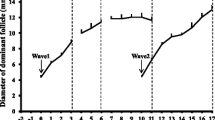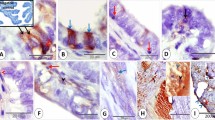Summary
Ultrastructure of the granulosa lutein cells of the raccoon from throughout pregnancy has been described. The lutein cells often from epithelial cords which are separated by the connective tissues, capillaries and lymphatics. Based on the arrangements and modifications of the cytoplasmic organelles and inclusions, three types of lutein cells have been recognized. The type I lutein cells predominantly contain tubular, agranular endoplasmic reticulum, juxtanuclear Golgi complexes, a few round to rod-shaped mitochondria, some free ribosomes, and occasional lipid droplets. Occasionally the tubular cristae of mitochondria and tubular smooth endoplasmic reticulum appear contiguous. The type II cells contain abundant lace-like and/or stacked fenestrated endoplasmic reticulum cisternae that frequently form membranous whorls, some tubular, agranular endoplasmic reticulum, mitochondria, and lipid droplets. Mitochondria are usually small, but unusual large ones also occur. The small, rod-to round-shaped mitochondria usually have tubular cristae; but the large, oval, elongate, and cup shaped mitochondria possess tubular, lamellar, plate like, and whorl-like cristae. The plasma membranes of the cells are complexly elaborated and folded, especially when apposing each other. In favorable sections, strands of fenestrated cisternae appose the folds of the plasma membranes. In general, the amount of cytoplasmic organelles and inclusions vary greatly in the cells. The type III cells predominantly contain lipid droplets and sparse cytoplasmic organelles. The type I and II cells are found throughout pregnancy, but the type III cells are observed from mid gestation to term. The cytological features of type I and II cells suggest that they probably secrete most of the steroids, whereas the type III cells primarily store lipids.
Similar content being viewed by others
References
Adams, E. C., Hertig, A. T.: Studies on the corpus luteum. I. Observations on the ultrastructure of development and regression of the luteal cells during the menstrual cycle. J. Cell Biol. 41, 696–715 (1969a).
—: Studies on the corpus luteum. II. Observations on the ultrastructure of luteal cells during pregnancy. J. Cell Biol. 41, 716–735 (1969b).
André, J.: Contribution a la connaissance du chondriome. Etude de ses modifications ultrastrucurales pendant la spermatogénèse. J. Ultrastruct. Res., Suppl. 3, 7–185 (1962).
Asdell, S. A.: Patterns of mammalian reproduction, 2nd ed. Ithaca, New York: Cornell University Press 1964.
Belt, W. D., Cavazos, L. F., Anderson, L. L., Kraeling, R. R.: Fine structure and progesterone levels in the corpus luteum of the pig during pregnancy and after hysterectomy. Biol. Reprod. 2, 98–113 (1970).
Bjersing, L.: On the ultrastructure of granulosa lutein cells in porcine corpus luteum, with special reference to endoplasmic reticulum and steroid hormone synthesis. Z. Zellforsch. 82, 187–211 (1967).
Blanchette, E. J.: Ovarian steroid cells. II. The lutein cell. J. Cell Biol. 31, 517–542 (1966).
Bowman, R. W.: Mitochondrial connections in canine myocardium. Tex. Rep. Biol. Med. 25, 517–524 (1967).
Brambell, F. W. R.: Ovarian changes. In: Marshall's physiology of reproduction (A. S. Parkes, ed), vol. 1, p. 397–542. London: Longmans Green and Co. 1956.
Canivenc, R., Cohere, G., Brechenmacher, C.: Quelques aspects ultrastructuraux de la cellule lutéale chez le Blaireau (Meles meles L.). C. R. Acad. Sci. (Paris) 264, 1187–1189 (1967).
Cavazos, L. F., Anderson, L. L., Belt, W. D., Hendricks, D. M., Kraeling, R. R., Melamphy, R. M.: Fine structure and progesterone levels in the corpus luteum of the pig during estrous cycle. Biol. Reprod. 1, 83–106 (1969).
Christensen, A. K.: The fine structure of testicular interstitial cells in guinea pigs. J. Cell Biol. 26, 911–935 (1965).
—, Fawcett, D. W.: The normal fine structure of opossum testicular interstitial cells. J. biophys. biochem. Cytol. 9, 653–670 (1961).
—: The fine structure of testicular interstitial cells in mice. Amer. J. Anat. 118, 551–571 (1966).
—, Gillim, S. W.: The correlation of fine structure and function in steroid-secreting cells, with emphasis on those of the gonads. In: The Gonads (K. W. McKerns, ed.), p. 415–488. New York: Appleton, Century, Crofts 1969.
Cohere, G. C., Brechenmacher, C., Mayer, G.: Variations des ultrastructures de la cellule lutéale chez la ratte au cours de la grossesse. J. Microscopie 6, 657–670 (1967).
Crisp, T. M., Dessouky, D. A., Denys, F. R.: The fine structure of the human corpus luteum of early pregnancy and during the progestational phase of the menstrual cycle. Amer. J. Anat. 127, 37–70 (1970).
Droz, B.: Synthèse et transfert des protéines cellulaires dans les neurones ganglionnaires. Etude radioautographique quantitative en microscopie électronique. J. Microscopie 6, 201–228 (1967).
Enders, A. C.: Observations on the fine structure of lutein cells. J. Cell Biol. 12, 101–113 (1962).
—: A comparative study of the fine structure of the trophoblast in several hemochorial placentas. Amer. J. Anat. 116, 29–68 (1965).
Fawcett, D. W.: Structural and functional variations in the membranes of the cytoplasm. In: Intracellular membranous structure (S. Seno and E. V. Cowdry, eds.), vol. 14, p. 15–40. Okayama, Japan: Japanese Society for Cell Biology 1963.
Gillim, S. W., Christensen, A. K., McLennan, C. E.: Fine structure of the human menstrual corpus luteum at its stage of maximum secretory activity. Amer. J. Anat. 126, 409–428 (1969).
Gordon, G. B., Miller, L. R., Bensch, K. G.: Electron microscopic observations of the gonad in the testicular feminization syndrome. Lab. Invest. 13, 152–160 (1964).
Harrison, R. J.: The development and fate of the corpus luteum in the vertebrate series. Biol. Rev. 23, 296–331 (1948).
—: The structure of the ovary. In: The ovary (S. Zuckerman, ed.), vol. 1, p. 143–187. New York: Academic Press 1962.
Karnovsky, M. J.: A formaldehyde-glutaraldehyde fixative of high osmolality for use in electron microscopy. J. Cell Biol. 27, 137 A (1965).
Luft, J. H.: Improvements in epoxy resin embedding methods. J. biophys. biochem. Cytol. 9, 409–414 (1961).
Reynolds, E. S.: The use of lead citrate at high pH as an electron-opaque stain in electron microscopy. J. Cell. Biol. 17, 208–212 (1963).
Rhodin, J. A. G., Terzakis, J.: The ultrastructure of the human full term placenta. J. Ultrastruct. Res. 6, 88–106 (1962).
Robertson, J. D.: Cell membranes and the origin of mitochondria. In: Regional neurochemistry (S. S. Ketz and J. Elkes, eds.), p. 497–530. New York: Pergamon Press 1961.
Ruby, J. R., Dyer, R. F., Skalko, R. G.: Continuties between mitochondria and endoplasmic reticulum in the mammalian ovary. Z. Zellforsch. 97, 30–37 (1969).
Sinha, A. A.: The intertubular cleft and membranous whorl in the rabbit placenta. Anat. Rec. 160, 187–200 (1968).
—, Seal, U. S.: The testicular interstitial cells of a lion and a three-toed sloth. Anat. Rec. 164, 35–46 (1969).
- - Doe, R. P.: Ultrastructure of the corpus luteum of the white-tailed deer during pregnancy. Amer. J. Anat. (in Press) (1971).
Toren, D., Memon, K. M. J., Forchielli, E., Dorfman, R. I.: In vitro enzymatic cleavage of the cholesterol side chain in rat testis preparations. Steroids 3, 381–390 (1964).
Author information
Authors and Affiliations
Additional information
This research was supported by UPSHS grant AM-11376 and NIH contract 69-2136.
Rights and permissions
About this article
Cite this article
Sinha, A.A., Seal, U.S. & Doe, R.P. Fine structure of the corpus Luteum of the raccoon during pregnancy. Z. Zellforsch. 117, 35–45 (1971). https://doi.org/10.1007/BF00331099
Received:
Issue Date:
DOI: https://doi.org/10.1007/BF00331099




